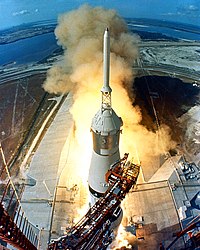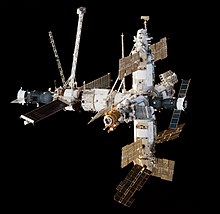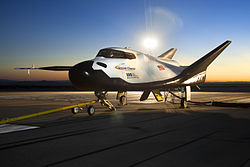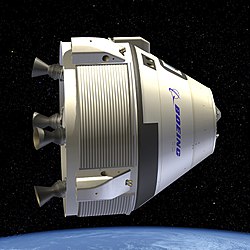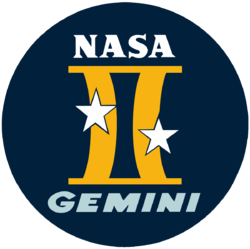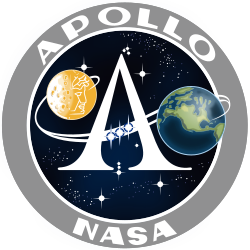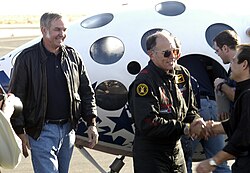Portal:Spaceflight/Selected article
This is the selected article subpage of the Spaceflight Portal. This page contains details of how to nominate or create future selected articles. Selected articles can be any page related to spaceflight, with the exception of articles about people, which are covered by the selected biography section. Well written and illustrated articles have more chance of being chosen, but there are no requisites for selection, and selection is not constrained to featured or good articles.
Usage
[edit]The layout used to format these sub-pages is at Portal:Spaceflight/Selected article/Layout
- Add a new selected article to the next available subpage.
- Update
"max="to new total for its{{Random portal component}}on the main page.
Selected article 1
Portal:Spaceflight/Selected article/1
The Shuttle–Mir program (Russian: Программа «Мир»–«Шаттл») was a collaborative space program between Russia and the United States that involved American Space Shuttles visiting the Russian space station Mir, Russian cosmonauts flying on the Shuttle, and an American astronaut flying aboard a Soyuz spacecraft to allow American astronauts to engage in long-duration expeditions aboard Mir.The project, sometimes called "Phase One", was intended to allow the United States to learn from Russian experience with long-duration spaceflight and to foster a spirit of cooperation between the two nations and their space agencies, the National Aeronautics and Space Administration (NASA) and the Russian Space Agency (PKA). The project helped to prepare the way for further cooperative space ventures; specifically, "Phase Two" of the joint project, the construction of the International Space Station (ISS). The program was announced in 1993, the first mission started in 1994 and the project continued until its scheduled completion in 1998. Eleven Space Shuttle missions, a joint Soyuz flight and almost 1,000 cumulative days in space for American astronauts occurred over the course of seven long-duration expeditions. In addition to Space Shuttle launches to Mir the United States also fully funded and equipped with scientific equipment the Spektr module (launched in 1995) and the Priroda module (launched in 1996), making them de facto U.S. modules during the duration of the Shuttle-Mir program.
During the four-year program, many firsts in spaceflight were achieved by the two nations, including the first American astronaut to launch aboard a Soyuz spacecraft, the largest spacecraft ever to have been assembled at that time in history, and the first American spacewalk using a Russian Orlan spacesuit.
Selected article 2
Portal:Spaceflight/Selected article/2
Gaganyaan ([ɡəɡənəjɑːnə]; pronunciation from Sanskrit: gagana, "celestial" and yāna, "craft, vehicle") is an Indian crewed orbital spacecraft intended to be the formative spacecraft of the Indian Human Spaceflight Programme. The spacecraft is being designed to carry three people, and a planned upgraded version will be equipped with rendezvous and docking capabilities. In its maiden crewed mission, the Indian Space Research Organisation (ISRO)'s largely autonomous 5.3-metric ton capsule will orbit the Earth at 400 km altitude for up to seven days with a two- or three-person crew on board. The first crewed mission was originally planned to be launched on ISRO's HLVM3 rocket in December 2021. As of November 2024, it is expected to be launched no earlier than 2026.
The Hindustan Aeronautics Limited (HAL)-manufactured crew module underwent its first uncrewed experimental flight on 18 December 2014. As of May 2019,[update] design of the crew module has been completed. Defence Research and Development Organisation (DRDO) will provide support for critical human-centric systems and technologies such as space-grade food, crew healthcare, radiation measurement and protection, parachutes for the safe recovery of the crew module, and the fire suppression system.
Selected article 3
Portal:Spaceflight/Selected article/3
The Proton (Прото́н) rocket (formal designation: UR-500, also known as D-1/ D-1e or SL-12/SL-13) is a Russian unmanned space vehicle design, first launched in 1965. It is still in use as of 2015 for both commercial and government launches. This makes it one of the most successful heavy boosters in the history of spaceflight. All Protons launch from Baikonur Cosmodrome in Kazakhstan.The name "Proton" originates from a series of large scientific satellites, which were among the rocket's first payloads. The enormous capacity of the new rocket allowed the heavy materials used in particle detectors. Thus the Proton satellites were pioneers of high-energy astronomy. Like many Soviet boosters, the name of the recurring payloads became associated with their launchers.
Payloads can be fitted with either a Blok D or Briz-M upper stage. Launch capacity to low Earth orbit is about 22 tonnes (44,000 lbm). Interplanetary transfer capacity is about 5–6 tonnes (11,000–13,000 lbm).
Selected article 4
Portal:Spaceflight/Selected article/4

Lunar orbit rendezvous (LOR) is a process for landing humans on the Moon and returning them to Earth. It was utilized for the Apollo program missions in the 1960s and 1970s. In a LOR mission, a main spacecraft and a lunar lander travel to lunar orbit. The lunar lander then independently descends to the surface of the Moon, while the main spacecraft remains in lunar orbit. After completion of the mission there, the lander returns to lunar orbit to rendezvous and re-dock with the main spacecraft, then is discarded after transfer of crew and payload. Only the main spacecraft returns to Earth.
Lunar orbit rendezvous was first proposed in 1919 by Ukrainian engineer Yuri Kondratyuk, as the most economical way of sending a human on a round-trip journey to the Moon.
Selected article 5
Portal:Spaceflight/Selected article/5
The Saturn V (pronounced "Saturn Five") was a multistage liquid-fuel expendable rocket used by NASA for Apollo and Skylab missions between 1967 and 1972. In total NASA launched twelve Saturn V rockets, plus one derived Saturn INT-21, with no loss of payload. It remains the largest and most powerful launch vehicle ever brought to operational status, in terms of height, mass and payload capacity. The Soviet Energia, which flew two test missions in the late 1980s before being cancelled, had slightly more takeoff thrust.The largest production model of the Saturn family of rockets, the Saturn V was designed under the direction of Wernher von Braun at the Marshall Space Flight Center in Huntsville, Alabama, with Boeing, North American Aviation, Douglas Aircraft Company, and IBM as the lead contractors. The three stages of the Saturn V were developed by various NASA contractors, but following a sequence of mergers and takeovers all of them are now owned by Boeing.
Selected article 6
Portal:Spaceflight/Selected article/6
Ariel 1, also known as UK-1 and S-55, was the first British satellite. Its launch in 1962 made the United Kingdom the third country to operate a satellite, after the Soviet Union and the USA. It was constructed in the United States by NASA, under an agreement reached as the result of political discussions in 1959 and 1960.NASA constructed and launched the satellite, whilst SERC provided the experiments, conducted operations, and later analysed and interpreted the results. Ariel 1 was launched aboard an American Thor-Delta rocket from Launch Complex 17A at the Cape Canaveral Air Force Station, on 26 April 1962. It decayed from orbit on 24 April 1976.
Selected article 7
Portal:Spaceflight/Selected article/7
Mir (Russian: Мир, IPA: [ˈmʲir]; lit. 'peace' or 'world') was a space station operated in low Earth orbit from 1986 to 2001, first by the Soviet Union and later by the Russian Federation. Mir was the first modular space station and was assembled in orbit from 1986 to 1996. It had a greater mass than any previous spacecraft. At the time it was the largest artificial satellite in orbit, succeeded by the International Space Station (ISS) after Mir's orbit decayed. The station served as a microgravity research laboratory in which crews conducted experiments in biology, human biology, physics, astronomy, meteorology, and spacecraft systems with a goal of developing technologies required for permanent occupation of space.
Mir was the first continuously inhabited long-term research station in orbit and held the record for the longest continuous human presence in space at 3,644 days, until it was surpassed by the ISS on 23 October 2010. It holds the record for the longest single human spaceflight, with Valeri Polyakov spending 437 days and 18 hours on the station between 1994 and 1995. Mir was occupied for a total of twelve and a half years out of its fifteen-year lifespan, having the capacity to support a resident crew of three, or larger crews for short visits.
Selected article 8
Portal:Spaceflight/Selected article/8
Soyuz (Russian: Союз, IPA: [sɐˈjus], lit. 'Union') is a series of spacecraft which has been in service since the 1960s, having made more than 140 flights. It was designed for the Soviet space program by the Korolev Design Bureau (now Energia). The Soyuz succeeded the Voskhod spacecraft and was originally built as part of the Soviet crewed lunar programs. It is launched atop the similarly named Soyuz rocket from the Baikonur Cosmodrome in Kazakhstan.
Following the Soviet Union's dissolution, Roscosmos, the Russian space agency, continued to develop and utilize the Soyuz. Between the Space Shuttle's 2011 retirement and the SpaceX Crew Dragon's 2020 debut, Soyuz was the sole means of crewed transportation to and from the International Space Station, a role it continues to fulfill. The Soyuz design has also influenced other spacecraft, including China's Shenzhou and Russia's Progress cargo vehicle.
Selected article 9
Portal:Spaceflight/Selected article/9
Salyut 6 (Russian: Салют 6, lit. 'Salute 6') was a Soviet orbital space station, the eighth station of the Salyut programme, and alternatively known DOS-5 as it was the fifth of the Durable Orbital Station series of civilian space stations. It was launched on 29 September 1977 by a Proton rocket. Salyut 6 was the first space station to receive large numbers of crewed and uncrewed spacecraft for human habitation, crew transfer, international participation and resupply, establishing precedents for station life and operations which were enhanced on Mir and the International Space Station.
Salyut 6 was the first "second generation" space station, representing a major breakthrough in capabilities and operational success. In addition to a new propulsion system and its primary scientific instrument—the BST-1M multispectral telescope—the station had two docking ports, allowing two craft to visit simultaneously. This feature made it possible for humans to remain aboard for several months. Six long-term resident crews were supported by ten short-term visiting crews who typically arrived in newer Soyuz craft and departed in older craft, leaving the newer craft available to the resident crew as a return vehicle, thereby extending the resident crew's stay past the design life of the Soyuz. Short-term visiting crews routinely included international cosmonauts from Warsaw pact countries participating in the Soviet Union's Intercosmos programme. These cosmonauts were the first spacefarers from countries other than the Soviet Union or the United States. Salyut 6 was visited and resupplied by twelve uncrewed Progress spacecraft including Progress 1, the first instance of the series. Additionally, Salyut 6 was visited by the first instances of the new Soyuz-T spacecraft.
Selected article 10
Portal:Spaceflight/Selected article/10
Skylon is a series of designs for a single-stage-to-orbit spaceplane by the British company Reaction Engines Limited (REL), using SABRE, a combined-cycle, air-breathing rocket propulsion system. The vehicle design is for a hydrogen-fuelled aircraft that would take off from a purpose-built runway, and accelerate to Mach 5.4 at 26 kilometres (85,000 ft) altitude (compared to typical airliners' 9–13 kilometres or 30,000–40,000 feet) using the atmosphere's oxygen before switching the engines to use the internal liquid oxygen (LOX) supply to take it into orbit. It could carry 17 tonnes (37,000 lb) of cargo to an equatorial low Earth orbit (LEO); up to 11 tonnes (24,000 lb) to the International Space Station, almost 45% more than the capacity of the European Space Agency's Automated Transfer Vehicle; or 7.3 tonnes; 7,300 kilograms (16,000 lb) to Geosynchronous Transfer Orbit (GTO), over 24% more than SpaceX Falcon 9 launch vehicle in reusable mode (As of 2018[update].) The relatively light vehicle would then re-enter the atmosphere and land on a runway, being protected from the conditions of re-entry by a ceramic composite skin. When on the ground, it would undergo inspection and necessary maintenance, with a turnaround time of approximately two days, and be able to complete at least 200 orbital flights per vehicle.Selected article 11
Portal:Spaceflight/Selected article/11
The V-2 (German: Vergeltungswaffe 2, "Vengeance Weapon 2"), technical name Aggregat-4 (A4), was the world's first long-range ballistic missile. It was developed during the Second World War in Germany, specifically targeted at London and later Antwerp.Commonly referred to as the V-2 rocket, the liquid-propellant rocket was a combat-ballistic missile, now considered short-range, and first known human artifact to enter outer space. It was the progenitor of all modern rockets, including those used by the United States and Soviet Union's space programs. During the aftermath of World War II the American, Soviet and British governments all gained access to the V-2's technical designs as well as the actual German scientists responsible for creating the rockets, via Operation Paperclip, Operation Osoaviakhim and Operation Backfire respectively.
The weapon was presented by Nazi propaganda as a retaliation for the bombers that attacked ever more German cities from 1942 until Germany surrendered.
Beginning in September 1944, over 3,000 V-2s were launched as military rockets by the German Wehrmacht against Allied targets during the war, mostly London and later Antwerp and Liège. According to a BBC documentary in 2011, the attacks resulted in the deaths of an estimated 9,000 civilians and military personnel, while 12,000 forced labourers and concentration camp prisoners were killed producing the weapons.
Selected article 12
Portal:Spaceflight/Selected article/12
Space Exploration Technologies Corp., commonly referred to as SpaceX, is an American space technology company. Since its founding in 2001, the company has made numerous advancements in rocket propulsion, reusable launch vehicle, human spaceflight and satellite constellation technology. By the late 2010s, SpaceX had become the world's dominant space launch provider, its launch cadence rivaling that of the Chinese space program and eclipsing all those of its private competitors. SpaceX, NASA and the United States Armed Forces work closely together by means of governmental contracts.
SpaceX was founded by Elon Musk in 2001 with a vision of decreasing the costs of space launches, paving the way to a sustainable colony on Mars. In 2008, when SpaceX was almost bankrupt, Falcon 1 successfully launched into orbit after three failed launch attempts. The company then pivoted towards the development of the larger Falcon 9 rocket and the Dragon 1 capsule to satisfy NASA's COTS contracts for deliveries to the International Space Station. By 2012, SpaceX finished all COTS test flights and began delivering Commercial Resupply Services missions to the International Space Station. Also around that time, SpaceX started developing hardware to make the Falcon 9 first stage reusable. The company demonstrated the first successful first-stage landing in 2015 and re-launch of the first stage in 2017. Falcon Heavy, built from three Falcon 9 boosters, first flew in 2018 after a more than decade-long development process. As of October 2024, the company's Falcon 9 rockets have landed and flown again more than 330 times, reaching 1-2 launches a week.
Selected article 13
Portal:Spaceflight/Selected article/13
The Cygnus spacecraft is an American automated cargo spacecraft developed by Orbital ATK as part of NASA's Commercial Orbital Transportation Services (COTS) developmental program. It is designed to transport supplies to the International Space Station (ISS) following the retirement of the American Space Shuttle. Since August 2000 ISS resupply missions have been regularly flown by Russian Progress (spacecraft), as well as by the European Automated Transfer Vehicle, and the Japanese H-II Transfer Vehicle. With the Cygnus spacecraft and the SpaceX Dragon, NASA seeks to increase its partnerships with domestic commercial aviation and aeronautics industry.Cygnus is the Latinized Greek word for swan and a northern constellation.
Not including its demonstration flight, Cygnus has been launched five times, with one, Cygnus CRS Orb-3, suffering a launch failure. Although designed to be launched by Orbital ATK's Antares rocket from Mid-Atlantic Regional Spaceport, damage to the launch pad caused by the Orb-3 failure led to two Cygnus missions being moved to Atlas V rockets launched from Cape Canaveral Air Force Station.
Cygnus was renewed for the second round of the Commercial Resupply Services in 2016.
Selected article 14
Portal:Spaceflight/Selected article/14
The Dream Chaser is an American reusable crewed suborbital and orbital lifting-body spaceplane being developed by Sierra Nevada Corporation (SNC) Space Systems. The Dream Chaser is designed to carry up to seven people to and from low Earth orbit. The vehicle would launch vertically on an Atlas V rocket and land horizontally autonomously on conventional runways.While Dream Chaser was not chosen for CCDev, it was chosen for the second round of the Commercial Resupply Services, to begin in 2019. A cargo version is being developed which will have folding wings so it can fit in the Atlas V's 5-meter fairing. It will be capable of carrying a total of 5,500 kg of cargo to the International Space Station, and return up to 1,750 kg of cargo to Earth.
Selected article 15
Portal:Spaceflight/Selected article/15
New Horizons is an interplanetary space probe that was launched as a part of NASA's New Frontiers program. Engineered by the Johns Hopkins University Applied Physics Laboratory (APL) and the Southwest Research Institute (SwRI), with a team led by S. Alan Stern, the spacecraft was launched with the primary mission to perform a flyby study of the Pluto system, and a secondary mission to fly by and study one or more other Kuiper belt objects (KBOs).On January 19, 2006, New Horizons was launched from Cape Canaveral Air Force Station directly into an Earth-and-solar escape trajectory. After a brief encounter with asteroid 132524 APL, New Horizons proceeded to Jupiter, making its closest approach on February 28, 2007. The Jupiter flyby provided a gravity assist that increased New Horizons' speed; the flyby also enabled a general test of New Horizons' scientific capabilities, returning data about the planet's atmosphere, moons, and magnetosphere.
Most of the post-Jupiter voyage was spent in hibernation mode to preserve on-board systems, except for brief annual checkouts. On December 6, 2014, New Horizons was brought back online for the Pluto encounter, and instrument check-out began. On January 15, 2015, the New Horizons spacecraft began its approach phase to Pluto.
On July 14, 2015, at 11:49 UTC, it flew 12,500 km (7,800 mi) above the surface of Pluto, making it the first spacecraft to explore the dwarf planet. Having completed its flyby of Pluto, New Horizons has maneuvered for a flyby of Kuiper belt object 2014 MU69, expected to take place on January 1, 2019, when it is 43.4 AU from the Sun.
Selected article 16
Portal:Spaceflight/Selected article/16
Dragon is a spacecraft developed by SpaceX. During its maiden flight in December 2010, Dragon became the first commercially built and operated spacecraft to be recovered successfully from orbit. On May 25, 2012, a cargo variant of Dragon became the first commercial spacecraft to successfully rendezvous with and be attached to the International Space Station (ISS). SpaceX is contracted to deliver cargo to the ISS under NASA's Commercial Resupply Services program, and Dragon began regular cargo flights in October 2012.The spacecraft is currently launched atop a Falcon 9 Full Thrust rocket. Earlier missions, through SpaceX CRS-2, used the original Falcon 9 rocket. Dragon has been launched on seven missions, with one, SpaceX CRS-7, suffering a launch failure.
Dragon was renewed for the second round of the Commercial Resupply Services in 2016. It is also the basis for the Dragon V2 manned spacecraft, which was selected under the CCDev program in 2014 to deliver astronauts to the ISS.
Selected article 17
Portal:Spaceflight/Selected article/17
The CST-100 Starliner is a spacecraft design under construction by Boeing in collaboration with Bigelow Aerospace as their entry for NASA's Commercial Crew Development (CCDev) program. Its primary mission is to transport crew to the International Space Station, and to private space stations such as the proposed Bigelow Aerospace Commercial Space Station.It is similar to the Orion, a spacecraft being built for NASA by Lockheed Martin. The capsule has a diameter of 4.56 meters (15.0 ft), which is slightly larger than the Apollo command module and smaller than the Orion capsule. The Starliner is to support larger crews of up to seven people. The CST-100 is designed to be able to remain on-orbit for up to seven months and for reusability for up to ten missions. It is to be compatible with multiple launch vehicles, including the Atlas V, Delta IV, and Falcon 9, as well as the planned Vulcan. The initial launch vehicle would be the Atlas V.
On September 16, 2014, NASA selected the CST-100, along with SpaceX's Dragon V2, for the Commercial Crew Transportation Capability (CCtCap) program, with an award of $4.2 billion. The spacecraft is expected to fly to the International Space Station with an astronaut aboard by December 2017.
Selected article 18
Portal:Spaceflight/Selected article/18
Project Mercury was the first human spaceflight program of the United States, running from 1958 through 1963. An early highlight of the Space Race, its goal was to put a human into Earth orbit and return the person safely, ideally before the Soviet Union. Taken over from the U.S. Air Force by the newly created civilian space agency NASA, it spanned twenty unmanned developmental missions involving test animals, and successful missions completed by six of the seven selected Mercury astronauts.The Space Race had begun with the 1957 launch of the Soviet satellite Sputnik 1. This came as a shock to the American public, and led to the creation of NASA to expedite existing U.S. space exploration efforts, and place most of them under civilian control. After the successful launch of the Explorer 1 satellite in 1958, manned spaceflight became the next goal.
The program took its name from the wing-footed, fleet god of travel in Roman mythology, and is estimated to have cost $2.24 billion (current prices) and to have involved the work of 2 million people. The astronauts were collectively known as the "Mercury Seven", and each spacecraft was given a name ending with a "7" by its pilot.
After a slow start riddled with humiliating mistakes, the Mercury Project gained popularity, its missions followed by millions on radio and TV around the world. Its success laid the groundwork for Project Gemini, which carried two astronauts in each capsule and perfected space docking maneuvers essential for lunar travel, and the subsequent Apollo Moon-landing program announced a few weeks after the first manned Mercury flight. However, they were unable to beat the Soviet space program to the goal of the first man in space, and emerged from the program still behind the Soviet Union.
Selected article 19
Portal:Spaceflight/Selected article/19
Project Gemini was NASA's second human spaceflight program. It was a United States space program started in 1961 and concluded in 1966. Project Gemini was conducted between projects Mercury and Apollo. The Gemini spacecraft carried a two-astronaut crew. Ten crews flew low Earth orbit (LEO) missions between 1965 and 1966. It put the United States in the lead during the Cold War Space Race with the Soviet Union.Its objective was to develop space travel techniques to support Apollo's mission to land astronauts on the Moon. Gemini achieved missions long enough for a trip to the Moon and back, perfected working outside the spacecraft with extra-vehicular activity (EVA), and pioneered the orbital maneuvers necessary to achieve space rendezvous and docking. With these new techniques proven in Gemini, Apollo could pursue its prime mission without doing these fundamental exploratory operations.
The astronaut corps that supported Project Gemini included the "Mercury Seven", "The New Nine", and the 1963 astronaut class. During the program, three astronauts died in air crashes during training, including the prime crew for Gemini 9. This mission was performed by the backup crew, the only time that had happened in NASA's history to that date.
Selected article 20
Portal:Spaceflight/Selected article/20
The Apollo program, also known as Project Apollo, was the third United States human spaceflight program carried out by the National Aeronautics and Space Administration (NASA), which accomplished landing the first humans on the Moon from 1969 to 1972. First conceived during Dwight D. Eisenhower's administration as a three-man spacecraft to follow the one-man Project Mercury which put the first Americans in space, Apollo was later dedicated to President John F. Kennedy's national goal of "landing a man on the Moon and returning him safely to the Earth" by the end of the 1960s.Kennedy's goal was accomplished on the Apollo 11 mission when astronauts Neil Armstrong and Buzz Aldrin landed their Lunar Module (LM) on July 20, 1969, and walked on the lunar surface, while Michael Collins remained in lunar orbit in the Command/Service Module (CSM), and all three landed safely on Earth on July 24. Five subsequent Apollo missions also landed astronauts on the Moon, the last in December 1972. In these six spaceflights, twelve men walked on the Moon.
Apollo ran from 1961 to 1972, and was supported by the two-man Gemini program which ran concurrently with it from 1962 to 1966. Gemini missions developed some of the space travel techniques that were necessary for the success of the Apollo missions. Apollo used Saturn family rockets as launch vehicles. Apollo/Saturn vehicles were also used for an Apollo Applications Program, which consisted of Skylab, a space station that supported three manned missions in 1973–74; and the Apollo–Soyuz Test Project, a joint Earth orbit mission with the Soviet Union in 1975.
The Apollo program succeeded in achieving its goal of manned lunar landing, despite the major setback of a 1967 Apollo 1 cabin fire that killed the entire crew during a pre-launch test. After the first landing, sufficient flight hardware remained for nine follow-on landings, with a plan for extended lunar geological and astrophysical exploration. Budget cuts forced the cancellation of three of these. Five of the remaining six missions achieved successful landings, but the Apollo 13 landing was prevented by an oxygen tank explosion in transit to the Moon, which disabled the command spacecraft's propulsion and life support. The crew returned to Earth safely by using the Lunar Module as a "lifeboat" for these functions.
Selected article 21
Portal:Spaceflight/Selected article/21
Soyuz 7K-T No.39, (also named Soyuz 18a or Soyuz 18-1) was an unsuccessful launch of a manned Soyuz spacecraft by the Soviet Union on April 5, 1975. The mission was expected to dock with the orbiting Salyut 4 space station, but due to a failure of the Soyuz launch vehicle the crew failed to achieve orbit.The accident was the result of a failure of a rocket staging event; the core booster of the Soyuz rocket did not separate from its upper stage. Since the accident took place after the escape tower had jettisoned, the Soyuz 7K-T spacecraft needed to use its own propulsion module engines to escape the failing rocket.
The escape exerted excessive g forces on the crew, consisting of commander Vasili Lazarev, an Air Force major, and flight engineer Oleg Makarov, a civilian. Both cosmonauts were injured, with Lazarev suffering injuries serious enough to end his career. The descent module landed near Aleysk, in the Altai Mountains; the crew initially feared they landed in the People's Republic of China, leading them to burn their paperwork in case they were captured by the Chinese, whom the Soviet Union were at odds with at the time.
The accident was disclosed by the normally secretive Soviets, as it occurred during preparations for their joint Apollo–Soyuz Test Project with the United States three months later. This would prove to be the last manned Soyuz mission launched with the original Soyuz rocket; future missions would be launched by the updated Soyuz-U rocket.
Selected article 22
Portal:Spaceflight/Selected article/22
Soyuz 7K-ST No. 16L (sometimes known as Soyuz T-10a or T-10-1) was an unsuccessful Soyuz mission intended to visit the Salyut 7 space station, which was occupied by the Soyuz T-9 crew.It was set to launch atop a Soyuz-U rocket on September 26, 1983. However, prior to launch, the rocket caught fire on its launch pad at Site 1/5, Baikonur Cosmodrome. The launch escape system of the Soyuz spacecraft fired two seconds before the launch vehicle exploded, saving the crew of commander Vladimir G. Titov and flight engineer Gennadi Strekalov. It is so far the only case in which a launch escape system has been fired with a crew aboard.
The mission was a visiting expedition to Salyut 7. The crew was scheduled to return in Soyuz T-9, leaving Soyuz T-10 for the crew on the space station to return in later. The failure briefly led to speculation in the West that the crew of Soyuz T-9 may be stranded on the space station, but this was never the case. That crew would return to Earth as normal on November 23, 1983, aboard Soyuz T-9.
Selected article 23
Portal:Spaceflight/Selected article/23
STS-71 was the third mission of the US/Russian Shuttle-Mir Program and the first Space Shuttle docking to Russian space station Mir. It started on June 27, 1995 with the launch of Space Shuttle Atlantis from launch pad 39A at the Kennedy Space Center in Florida.As part of the mission, Atlantis engaged in the Shuttle program's first space station crew transfer. The shuttle delivered the Mir Expedition 19 crew of Anatoly Solovyev and Nikolai Budarin; and returned the Expedition 18 crew of cosmonauts Gennadi Strekalov and Vladimir Dezhurov, and astronaut Norman Thagard. It was the first of seven straight missions to Mir flown by Atlantis.
For the five days the shuttle was docked to Mir they were the largest spacecraft in orbit at the time. In addition to the crew transfer, STS-71 marked the first docking of a space shuttle to a space station, and the 100th manned space launch by the United States. The mission carried Spacelab, and included a logistical resupply of Mir. Together the shuttle and station crews conducted various on-orbit joint US/Russian life science investigations with Spacelab along with the Shuttle Amateur Radio Experiment-II (SAREX-II) experiment.
Atlantis returned to Earth on July 7, becoming the first mission to land with a crew of eight since STS-61-A in 1985.
Selected article 24
Portal:Spaceflight/Selected article/24
Flight 15P of SpaceShipOne (X0) was the first privately funded human spaceflight. It took place on June 21, 2004. It was the fourth powered test flight of the Tier One program, the previous three test flights having reached much lower altitudes. The flight carried only its pilot, Mike Melvill, who thus became the first non-governmental astronaut.This flight was a full-altitude test. SpaceShipOne was dropped from its carrier aircraft, White Knight, at 14:50 UTC (7:50am PDT), at an altitude of 47,000 feet (14,000 m), and fired its on-board rocket for 76 seconds. It reached a peak altitude of 328,491 feet (100,124 m), becoming the first commercial manned spacecraft to cross the Kármán line. It landed safely at Mojave Air and Space Port, California, 15:14 UTC (8:14am PDT).
Flight 15P was a test flight to prepare Scaled Composites to compete for the Ansari X Prize, the prize for the first non-governmental reusable manned spacecraft. Scaled Composites would win the Ansari X Prize in October 2004 after two more successful flights.
Selected article 25
Portal:Spaceflight/Selected article/25
Crew Dragon Demo-2 (officially Crew Demo-2, SpaceX Demo-2, or Demonstration Mission-2) was the first crewed test flight of the Crew Dragon spacecraft. The spacecraft, named Endeavour, launched on 30 May 2020 at 19:22:45 UTC (3:22:45 PM EDT) on top of Falcon 9 Booster B1058.1, and carried NASA astronauts Doug Hurley and Bob Behnken to the International Space Station in the first crewed orbital spaceflight launched from the United States since the final Space Shuttle mission, STS-135, in 2011, and the first ever operated by a commercial provider. Demo-2 was also the first two-person orbital spaceflight launched from the United States since STS-4 in 1982.Demo-2 was intended to complete the validation of crewed spaceflight operations using SpaceX hardware and to receive human-rating certification for the spacecraft including astronaut testing of Crew Dragon capabilities on orbit. During their time aboard, Behnken conducted four spacewalks with fellow American astronaut Chris Cassidy to replace batteries brought up by a Japanese cargo vehicle.
Docking and undocking operations were autonomously controlled by the Crew Dragon, but monitored by the flight crew in case manual intervention became necessary. The spacecraft soft docked with the International Space Station at 14:16 UTC on 31 May 2020. Following soft capture, 12 hooks were closed to complete a hard capture 11 minutes later. Hurley and Behnken worked alongside the crew of Expedition 63 for 62 days. Endeavour autonomously undocked from the station at 23:35 UTC on 1 August 2020 and returned the astronauts to Earth on 2 August 2020 in the first water landing by astronauts since 1975.
Selected article 26
Portal:Spaceflight/Selected article/26
The SpaceX Dragon 2 is a class of reusable spacecraft developed and manufactured by American aerospace manufacturer SpaceX as the successor to Dragon 1, a reusable cargo spacecraft. There are two variants: Crew Dragon, a space capsule capable of ferrying up to seven astronauts, and Cargo Dragon, an updated replacement for the original Dragon spacecraft. The spacecraft launches atop a Falcon 9 Block 5 rocket and returns to Earth via an ocean splashdown. Unlike its predecessor, the spacecraft can autonomously dock to the International Space Station (ISS) instead of being berthed. Crew Dragon is equipped with an integrated launch escape system (LES) capable of accelerating the vehicle away from the rocket in an emergency at 11.8 m/s2 (39 ft/s2), accomplished using four side-mounted thruster pods, each with two SuperDraco engines. The spacecraft features redesigned solar arrays and a modified outer mold line compared to the original Dragon, and possesses new flight computers and avionics.Crew Dragon serves as one of two spacecraft that are expected to transport crews to and from the ISS under NASA's Commercial Crew Program, the other being the Boeing CST-100 Starliner; both craft succeeding the crew orbital transportation capabilities of the U.S. Space Shuttles which retired from service in 2011. It is also expected to be used in flights by American space tourism company Space Adventures and to shuttle tourists to and from Axiom Space's planned space station. Crew Dragon's first uncrewed test flight occurred in March 2019, and its first crewed test flight – with astronauts Bob Behnken and Doug Hurley – occurred in May 2020. This marked the first time a private company launched a crewed orbital spacecraft. The first flight of a Cargo Dragon launched in December 2020.
Selected article 27
Portal:Spaceflight/Selected article/27
Starship is a reusable launch vehicle in development by private aerospace company SpaceX, consisting of a first-stage named Super Heavy and a second-stage named Starship. The launch vehicle can produce 72 meganewtons (MN) or 17,000,000 pound-force (lbf) at lift-off, which would make it the world's most powerful rocket once operational. Starship is designed to launch 100 metric tons (220,000 lb) to low Earth orbit. If tanker Starships transferred propellant to the main spacecraft, the same amount of payload would be able to go to higher Earth orbits, the Moon, or Mars. Starship might launch from a non-traditional launch pad that includes a specialized launch tower, able to lift and recover Starship's stages. The rocket is made from stainless steel and has liquid oxygen and liquid methane-consuming Raptor engines.The first publicly known Starship-like concept by SpaceX was a rocket code-named BFR. After changes to the vehicle's design, SpaceX began to build and develop Starship test articles at its Boca Chica launch site. On 25 July 2019, Starhopper performed the first successful hop using its Raptor engine. The first complete Starship test article was SN8, which launched and crashed to the ground on 9 December 2020. SN15 on 5 May 2021 became the first test article to launch and land without self-destruction. As of October 2021, SN20 and booster BN4 are planned for Starship's first orbital flight. Starship is projected to be used in upcoming and envisioned space missions, such as the dearMoon project, NASA's Artemis program, and SpaceX's Mars program.
Selected article 28
Selected article 29
Selected article 30
Additions
[edit]Feel free to add any Featured or Good articles to the list above.
Archive
[edit]For older selected articles, please see the Archive, for Space exploration portal selected articles, see this archive.
How to add a selected article
[edit]- Click on the redlink in the current year's section of the table for the week that you want it to be the selected article
- Paste the template code into this new article:
{{subst:Portal:Spaceflight/Selected article/Template|article title|article description|image|image description}}
- Enter the title of the corresponding article in place of the text article title
- Enter the main text of your selected article entry in place of the text article description (remember to link to appropriate articles)
- Select a suitable image, and type its name it in place of the text image (omit the "Image:" prefix)
- Note: since this will be in the Portal: namespace, non-free images cannot be used.
- Enter a caption for the image in place of the text image description.
- Preview and save




